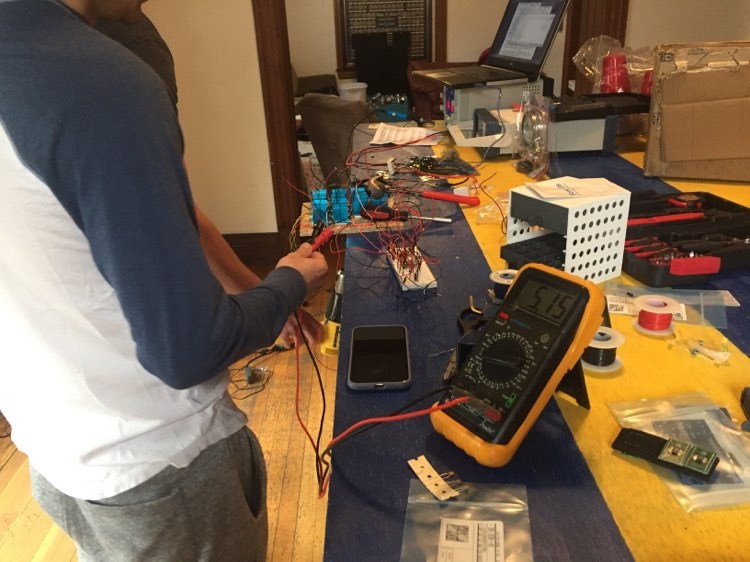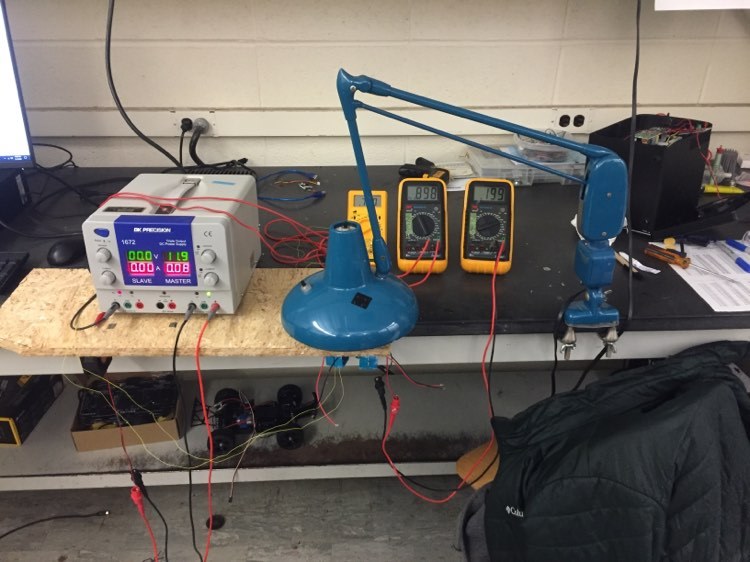Team Members
Jake Hertz
Wade Bennett
Joe Nictonia
Aidan Miller
Supervisors
Jack Mottley, Dan Phinney
Customers
NA
Description
The motivating question that our project sought to solve was “How can we harvest renewable energy in places where solar isn’t feasible?” We attempted to solve this problem by creating a system that harvested heat, specifically temperature differentials, instead of direct sunlight. Baseline application is capturing the temperature differential created by the sun between a roof and the inside of an attic. Further applications include using black body emissivity and radiative cooling to provide solar energy harvesting in places where traditional voltaic cells are not feasible.


CONCEPT
Our idea was initially inspired by a conversation with an architect who discussed how modern housing systems employ a Soffit-Ridge ventilation system to create natural airflow.
On a summer day, this ventilation system works to cool the entire of the attic. Meanwhile, hot sunlight is shining and being absorbed by shingles on the roof. This natural process creates a temperature differential between the inside and outside of the roof.
We looked to exploit this naturally occurring temperature differential utilizing the Seebeck Effect. The Seebeck Effect is a phenomenon in which a temperature difference between two dissimilar electrical conductors or semiconductors produces a voltage difference between the two substances. Thermoelectric Generators (TEGs) are devices, which we used in our project, that were created for this purpose.
Our goal in this project was to create an electrical system, using these TEGs, that could reliably and efficiently harvest, regulate, and store electrical energy.
METHOD
4 Series TEGs→ LTC3109 → LTC4070 → Li-Ion Battery
Our setup consisted of 4 TEG’s in a series array feeding into the LTC3109, which is our power management IC. The input voltage arising from this arrangement allowed us to have the LTC3109 operating in its most efficient range. We configured the LTC3109 to output a constant 5V. We then tied the LTC3109 outputs in parallel to sum their current outputs. These tied outputs were fed into the LTC4070, which is a LI-Ion battery charger. This is then fed into our battery.
We took a ½” piece of wood (to simulate a roof) and cut sixteen 25 mm x 25mm holes, ½” apart in it to place our TEGs in. To optimize thermal flow, we equipped each TEG with thermal paste and a heatsink.
In our research we concluded that the average temperature gradient between the outside and inside of a roof, over a 24 hour period, was 10 degrees Fahrenheit. To simulate this, we applied a constant 10 degree temperature differential to our system by using a heat gun with a temperature feedback sensor. Soffit-Ridge airflow was emulated using CPU fans.
RESULTS
With our setup we calculated the output current of our LTC3109 to different resistivity loads.
What we see is that when the load is too small (10k), our IC cannot produce enough current to maintain a 5V differential, so the output voltage drops. For this reason we tested loads until we saw that at a 33k load is the lowest that our IC can maintain a 5V output across (4.9V). Hence, this is the maximum power output of our setup, at a 10 degree differential, measured to be .728mW at 5V.
The table below shows how our system compares to solar in varying aspects.
COMPARING TO SOLAR – LOW LIGHT CONDITIONS
With the data that we produced, we were able to make calculations on how the system would perform on a roof in different climates.
First, the calculations were made for Rochester weather. Accounting for daylight hours, cloud cover, snow covering panels, and peak angle of sun, we found the panels would produce about 57,000,000 Wh every year.
For our TEG system, we assume that there is a constant 10 degree difference 24 hours a day. Over the course of a year, this would produce about 33,500 Wh.
Clearly, even in a place like Rochester where there is a lack of sun, solar is still superior. However, there are places on Earth that receive far less sunlight. These places are where our system would thrive.
We found that Rjukan, Norway would be an ideal city for our system to work. Rjukan is very North, meaning that during certain seasons it receives very little sunlight if any. This is compounded by the fact that it is in the valley of several mountains that cast shadows. This causes the city to go 6 months out of the year without seeing any sunlight. Therefore, during these six months, solar panels would generate 0 Wh while our system would generate over 16,000 Wh.
POTENTIAL IMPROVEMENT – RADIATIVE COOLING
TEGs have also been used in other research as a way to capture energy from temperature differences generated radiative cooling. Radiative cooling transfers heat energy through radiation into the cold of space through atmospheric windows at certain wavelengths. This effect is observable at night when the ground is colder than the ambient temperature. Typically, radiative cooling is ineffective during the day because the energy imparted by the sun surpasses the ability to radiatively cool. The effectiveness of radiative cooling relates to the surface’s emissivity value, which according to Kirchoff’s law of thermal radiation is directly related to the absorptivity.
This technique would improve the performance of our system to allow increased nighttime operation with little additional cost. Additionally, the black paint coated aluminum would absorb more energy during the day, potentially improving daytime performance. Aluminum is already used as a roofing material, though this particular construction might impact the temperature regulation system of the house.
SHORTCOMINGS OF OUR SYSTEM
As displayed, we are still a long way from being able to implement this type of system. For one, TEGs are currently way too inefficient. Add that to the losses imposed by the LTC3109 inherent to DC-DC converters, and the system shows poor performance. TEG costs are also very high, making this system economically impractical. The hope is that as this technology improves, better price points and efficiencies can be reached to match solar panels. There are also areas of research in improving the performance of current TEGs, which is touched on below.
Despite these shortcomings, there are benefits to our system. One such benefit, is that the system can constantly generate power as it does not rely on sunlight (night-time operation). As long as there is a temperature gradient, it will run. It also supports dual polarity, so will work if the temperature differential flips. Furthermore, the system is relatively simple/easy to implement, can easily be made robust, and has a small profile.
Even though the shortcomings discussed make the system impractical in regards to the initially proposed scale (roofing system), there are also several other application areas where this system can be used (potentially with modifications). One example of this is on a car engine block, where the wasted heat can be captured and turned into power for charging the battery or running electronics. Other examples include a fireside device charger for camping, or powering wearables.
